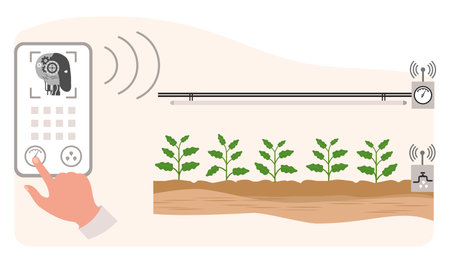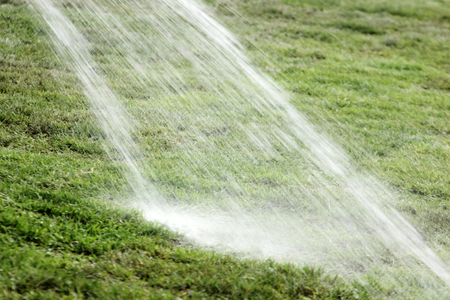Assessing Your Backyards Watering Needs
Before setting up an irrigation system, its important to understand what your backyard actually needs in terms of water. Every yard is different, so taking the time to evaluate key factors will help you design a system that’s both effective and efficient. Heres what to look at:
1. Measure Your Backyard Size
Start by measuring the total area of your backyard. This helps determine how much piping, tubing, or sprinkler coverage youll need. Break down the space into zones—like lawn, flower beds, veggie gardens, and trees—so each can get the right amount of water.
2. Identify Plant Types
Different plants need different amounts of water. Group them by their watering needs—this way, you avoid overwatering some while underwatering others. For example, succulents and native plants typically need less water than vegetables or tropical flowers.
| Plant Type | Watering Frequency | Notes |
|---|---|---|
| Succulents & Cacti | Once every 1-2 weeks | Drought-tolerant; avoid overwatering |
| Lawn Grass | 2-3 times per week | Needs consistent watering during hot months |
| Vegetables | Daily or every other day | High water needs, especially in summer |
| Perennials & Shrubs | 1-2 times per week | Water deeply but less often |
3. Check Soil Conditions
Your soil type affects how well it holds water. Sandy soils drain quickly and may require more frequent watering, while clay soils retain moisture longer but can become compacted.
| Soil Type | Drainage Rate | Irrigation Tip |
|---|---|---|
| Sandy | Fast draining | Shorter, more frequent watering cycles work best |
| Clay | Slow draining | Water less often but for longer durations to soak roots deeply |
| Loamy (Ideal) | Moderate drainage | Easiest to manage with balanced watering schedule |
4. Observe Sun Exposure Zones
The amount of sunlight different areas of your yard receive will impact how quickly they dry out. Full-sun areas usually need more frequent watering compared to shaded spots.
Tips for Mapping Sunlight:
- Full Sun: Gets 6+ hours of direct sunlight – needs more water.
- Partial Sun/Shade: Gets about 3–6 hours – moderate watering needed.
- Full Shade: Less than 3 hours – minimal watering required.
Create a Watering Map
A simple sketch of your backyard showing plant zones, soil types, and sun exposure can help you plan where to place sprinklers or drip lines for optimal efficiency.
This assessment step lays the foundation for designing a smart irrigation system tailored to your specific backyard environment.
2. Choosing the Right Irrigation System
Before installing a backyard irrigation system, it’s important to understand the different types available and how they work best in various parts of your yard. The right system can save water, reduce utility bills, and keep your landscape healthy with minimal effort.
Drip Irrigation
Drip systems deliver water directly to the base of plants through small tubes and emitters. This method is highly efficient because it minimizes evaporation and runoff, making it ideal for flower beds, vegetable gardens, and shrubs.
Pros:
- Conserves water by targeting plant roots directly
- Reduces weed growth since non-planted areas stay dry
- Great for uneven terrain or mulched areas
Cons:
- Can clog without proper filtration
- Initial setup takes time and planning
Soaker Hoses
Soaker hoses are porous hoses that allow water to seep out along their length. They’re simple to install and work well for rows of plants or hedges.
Pros:
- Easy to lay out and connect to a hose bib
- Good option for tight budgets
- Covers long, narrow garden spaces effectively
Cons:
- Water distribution can be uneven on slopes
- Difficult to control output precisely
Sprinkler Systems
Sprinklers spray water over a wide area, mimicking rainfall. They’re most commonly used for lawns but can also water large garden beds if set up correctly.
Pros:
- Covers large areas quickly
- User-friendly with automatic timers and zones
- Ideal for grass lawns and flat terrain
Cons:
- Loses water due to evaporation and wind drift
- May encourage weed growth in unintended areas
Irrigation System Comparison Table
| Irrigation Type | Best For | Water Efficiency | Ease of Installation |
|---|---|---|---|
| Drip Irrigation | Shrubs, flowers, vegetable gardens | High (targets roots) | Moderate (requires planning) |
| Soaker Hose | Hedges, narrow garden beds, rows of plants | Moderate (some surface loss) | Easy (lay-and-use) |
| Sprinkler System | Lawn areas, large open spaces | Low-Moderate (evaporation loss) | Difficult (requires zoning & setup) |
Selecting the Right System for Each Zone
Your backyard may have different zones that require separate irrigation solutions. For example, use drip irrigation in flower beds where precise watering is needed. Soaker hoses can serve raised garden boxes or dense plantings. Sprinklers work best for grassy areas where broad coverage is necessary.
Zoning Tip:
If youre combining systems, consider using a multi-zone timer that lets you control each area separately based on its unique watering needs.
An efficient backyard irrigation system isn’t one-size-fits-all — choosing the right type for each zone will help you conserve water and keep your garden thriving.

3. Designing the Layout of the Irrigation System
Now that you’ve chosen the right irrigation method for your backyard, it’s time to plan out where everything will go. A well-thought-out layout helps ensure water reaches all the right places without wasting a drop. You’ll want to map out where to place pipes, emitters, and sprinklers based on your yard’s shape, plant types, and their water needs.
Understand Your Landscape
Start by sketching a simple map of your backyard. Include areas like lawns, flower beds, vegetable gardens, trees, walkways, and patios. Note which areas need more water (like grass or vegetables) and which need less (like drought-tolerant plants). This helps you decide where to place high-flow versus low-flow irrigation components.
Plan Water Zones
Dividing your yard into zones allows you to control how much water each area gets. Each zone should group plants with similar water needs together. For example:
| Zone | Plant Type | Water Requirement | Recommended Irrigation |
|---|---|---|---|
| Zone 1 | Lawn | High | Sprinkler System |
| Zone 2 | Vegetable Garden | Medium to High | Drip Irrigation or Soaker Hose |
| Zone 3 | Drought-Tolerant Plants | Low | Drip Emitters |
Pipe Placement Tips
Main water lines should run along the longest sections of your yard to minimize pipe length. Branch lines can extend from there into different zones. Keep pipe routes as straight as possible and avoid sharp bends, which can reduce water pressure.
PVC vs. Poly Tubing
- PVC Pipes: Durable and great for underground use, especially in sprinkler systems.
- Poly Tubing: Flexible and easy to install above ground; perfect for drip irrigation setups.
Selecting Emitters and Sprinklers
The type of water delivery device you use depends on the plants in each zone:
- Sprinklers: Best for covering large lawn areas evenly.
- Bubblers: Ideal for trees or shrubs that need deep watering at the base.
- Drip Emitters: Perfect for flower beds or individual plants needing slow, steady moisture.
- Soaker Hoses: Great for rows of vegetables or dense planting beds.
Avoid Overwatering and Waste
Avoid overlapping sprinkler spray patterns—this can lead to puddles and wasted water. Make sure emitters are placed close enough to cover root zones but not so close that they cause runoff. Adjust spacing depending on soil type: sandy soil drains quickly and may require closer placement, while clay holds water longer and can be spaced farther apart.
Quick Tip:
If youre unsure about spacing or pressure requirements, check manufacturer guidelines for emitters and sprinkler heads—they usually include helpful charts based on flow rate and coverage radius.
An efficient layout ensures every drop counts—keeping your garden green while saving money on your water bill.
4. Installing and Setting Up the System
Once youve planned your irrigation layout and purchased your materials, its time to install and set up your backyard irrigation system. In the U.S., most homeowners can find everything they need at popular hardware stores like Home Depot, Lowes, or local garden centers. Follow these steps to ensure a smooth installation that meets local building codes and delivers long-lasting performance.
Step 1: Gather Your Tools and Materials
Before starting, make sure you have all necessary components and tools on hand. Heres a basic checklist:
| Item | Description | Available At |
|---|---|---|
| PVC or Poly Tubing | Main water lines for delivering water across your yard | Home Depot, Lowe’s |
| Sprinkler Heads or Drip Emitters | Delivers water directly to plants or lawn areas | Hardware stores, Garden centers |
| Backflow Preventer | Keeps contaminated water from re-entering your home’s supply | Plumbing section of most U.S. stores |
| Irrigation Valves | Controls different zones in your system | Home Depot, Online retailers |
| Timer/Controller | Automates watering schedules | Lowe’s, Smart home sections online |
| Teflon Tape & PVC Cement | Ensures leak-free pipe connections | Plumbing aisles in hardware stores |
Step 2: Install Water Source Connection
If youre connecting to an outdoor spigot or tapping into a main line, make sure to turn off the water before making any connections. Use a backflow preventer as required by many local codes in the U.S. Install a splitter if needed so you can still use the hose bib separately.
Step 3: Lay Out Main and Lateral Lines
Dig shallow trenches (typically 6–12 inches deep) for your main supply lines using a trenching shovel. Lay out the tubing or PVC pipe according to your plan. Use elbows and tees where necessary and secure them with PVC cement or compression fittings depending on the material type.
Step 4: Install Valves and Zone Controls
If you have multiple zones, install an irrigation valve manifold near the water source. Connect each valve to its corresponding zone line and wire them back to your controller. Make sure valves are easily accessible for maintenance.
Step 5: Set Up Sprinkler Heads or Drip Emitters
For sprinkler systems, attach risers and heads based on plant coverage needs. For drip systems, punch holes in the tubing and insert emitters close to the plant roots. Secure tubing with stakes to keep it in place.
Step 6: Connect Controller and Test System
Install your irrigation timer in a weatherproof area, preferably near a power source. Connect wires from each valve to the controller following manufacturer instructions. Once wired, program each zone with appropriate run times based on plant needs and local climate.
Irrigation Timing Tips by Region:
| U.S. Region | Irrigation Frequency (Summer) | Best Time of Day to Water |
|---|---|---|
| Southwest (e.g., Arizona) | 3–4 times per week | Early morning (4–6 AM) |
| Southeast (e.g., Florida) | 2–3 times per week | Dawn or dusk hours |
| Northeast (e.g., New York) | 1–2 times per week depending on rainfall | Morning (5–7 AM) |
| Pacific Northwest (e.g., Oregon) | Once weekly or less with rain sensors | Mid-morning (7–9 AM) |
Pro Tip:
If youre using a smart controller, link it with local weather data to automatically skip watering on rainy days—this helps save water and stay compliant with drought regulations in some states like California.
An efficient setup not only saves time but also conserves water while keeping your landscape healthy throughout the growing season.
5. Automating and Maintaining Your System
Once youve set up your backyard irrigation system, its time to make it efficient and low-maintenance. Automation and regular upkeep are key to keeping your lawn and garden healthy without wasting water or time.
Use Smart Controllers or Timers
Smart irrigation controllers or timers allow you to automate your watering schedule based on the needs of your landscape and local weather conditions. They can be connected to Wi-Fi and paired with weather apps to adjust watering times automatically. This helps reduce water usage and ensures your plants get just the right amount of moisture.
Benefits of Smart Controllers
| Feature | Benefit |
|---|---|
| Weather-Based Adjustments | Reduces watering during rain or cool days |
| Mobile App Control | Convenient scheduling from your phone |
| Water Usage Monitoring | Tracks consumption to save on water bills |
Set a Watering Schedule
A good rule of thumb is to water early in the morning or late in the evening when evaporation rates are lower. Most lawns only need about 1 inch of water per week, including rainfall. Use your controller to set a schedule that matches your region’s climate and seasonal changes.
Perform Regular Maintenance
Your system will only run efficiently if you keep it clean and in good working order. Check for leaks, clogs, or broken sprinkler heads at least once a month. Also, flush out drip lines and filters to prevent blockages.
Irrigation Maintenance Checklist
| Task | Frequency |
|---|---|
| Check for leaks or damaged parts | Monthly |
| Clean filters and nozzles | Every 2-3 months |
| Adjust sprinkler heads for coverage | Seasonally |
| Test smart controller settings | Quarterly |
By automating your system with smart technology and staying on top of maintenance, you can enjoy a lush, green backyard without the guesswork or wasted water.


